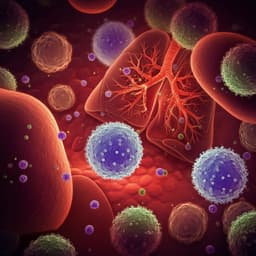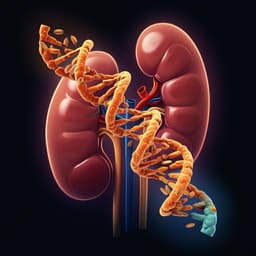
Psychology
Connectome dysfunction in patients at clinical high risk for psychosis and modulation by oxytocin
C. Davies, D. Martins, et al.
Explore groundbreaking insights into the functional brain networks linked to psychosis risk! This pioneering research, conducted by a team of experts including Cathy Davies and Daniel Martins at King’s College London, reveals how intranasal oxytocin affects network topology differently in individuals at Clinical High Risk for Psychosis compared to healthy controls. Delve into the implications for understanding psychosis onset!
~3 min • Beginner • English
Introduction
Abnormal functional connectivity is a prominent biological marker of psychosis and is present before disorder onset in people at clinical high risk (CHR-P). CHR-P individuals exhibit attenuated psychotic symptoms, cognitive and functional impairments, and carry an estimated 20% two-year transition risk to psychosis. There are currently no licensed pharmacological treatments for CHR-P, creating an unmet need. Neuroimaging evidence implicates widespread and regional dysfunction across hippocampus, striatum, thalamus, and frontal cortex, core components of circuit models of psychosis. Resting-state studies show dysconnectivity within and between large-scale networks, including frontoparietal, default mode, and salience networks, indicating that network-level approaches are required to capture the full spectrum of dysfunction. Graph theory enables characterization of brain network topology from global to local scales, where disruptions in integration vs segregation can impair information transfer and cognition, potentially contributing to psychotic phenomenology. Established psychosis shows altered global and local topology (e.g., reduced small-worldness, clustering, hubness, modularity, and altered efficiencies), but CHR-P network dysfunction is less well characterized. Limited studies suggest baseline modular abnormalities predict transition, with altered centrality in frontal and cingulate regions, reduced global efficiency and clustering (not always replicated), nodal efficiency changes correlating with symptoms, and widespread reorganization of community structure. Oxytocin is a potential treatment with anxiolytic, social-emotional, and HPA axis effects, and in CHR-P has been shown to modulate frontal activation, ACC neurochemistry, and hippocampal perfusion. In healthy volunteers, oxytocin modulates resting network connectivity and may normalize aberrant connectivity in several clinical groups. A recent study in healthy men showed a single oxytocin dose modulates local network topology, raising the possibility it could ameliorate CHR-P connectomic dysfunction. Preclinical work indicates oxytocin targets fast-spiking GABAergic interneurons, potentially improving signal-to-noise across networks, among other mechanisms relevant to psychosis. Whether oxytocin exerts similar connectomic effects in CHR-P as in healthy individuals is unknown; prior findings of differential autonomic effects (e.g., increased cardio-parasympathetic activity in CHR-P but not controls) suggest clinical status-specific effects. The present study used multi-echo resting-state fMRI and graph theory to assess group differences (CHR-P vs controls), oxytocin vs placebo treatment effects, and group-by-treatment interactions on global and regional functional connectome topology.
Literature Review
Prior work indicates widespread brain dysfunction in CHR-P and established psychosis, particularly in hippocampus, striatum, thalamus, and frontal cortex. Resting-state connectivity studies identify dysconnectivity within and between large-scale networks (frontoparietal, default mode, salience). Graph theoretical analyses in psychosis show abnormalities in global and nodal properties, including reduced small-worldness, clustering, hubness, modularity, and altered efficiencies. In CHR-P, abnormalities in modular organization predict transition risk; transitions show altered centrality in frontal/anterior cingulate regions, reduced global efficiency and clustering (with mixed findings), regional nodal efficiency changes related to symptom severity, and reorganization of community structure. Oxytocin modulates resting-state network connectivity in healthy individuals and has reported normalizing effects in social anxiety, PTSD, and autism. In healthy men, a single oxytocin dose modulates local network topology, including regions implicated in psychosis risk. Mechanistically, oxytocin may enhance spike transmission via GABAergic interneurons, improving signal-to-noise and influencing network topology, with potential relevance to psychosis pathophysiology.
Methodology
Design and participants: Two related randomized, double-blind, placebo-controlled crossover studies were combined. CHR-P cohort: 30 male help-seeking individuals (18–35 years) meeting CAARMS 12/2006 criteria, recruited from a London early detection service (ISRCTN48799530). Healthy controls: 17 males (19–34 years) from a triple-dummy crossover study; only nasal spray oxytocin and placebo arms were used to match the CHR-P protocol. Exclusions: 2 CHR-P (protocol violation; excessive motion), yielding n=28 CHR-P and n=17 controls for analysis. Participants abstained from recreational drugs (≥1 week) and alcohol (≥24 h) prior to visits; urine screens were conducted. Ethics approvals obtained; written informed consent provided. Interventions: Intranasal oxytocin 40 IU or placebo delivered via standard nasal spray; CHR-P study used two sessions with one-week washout; control study used fixed sequences across spray, nebulizer, and IV in a triple-dummy design, but only spray and matched placebo data were analyzed for this work. Imaging acquisition: Resting-state multi-echo BOLD fMRI acquired on a GE Discovery MR750 3T with a 32-channel head coil at ~62.6±3.1 min post-dosing in CHR-P and 57.01±3.38 min in controls. Preprocessing and denoising used AFNI ME-ICA (MEICA.py). Functional connectivity construction: BOLD time series were extracted per session using fslmeants for 66 cortical ROIs (Desikan-Killiany atlas) plus 9 bilateral subcortical regions (cerebellum, thalamus, caudate, putamen, pallidum, hippocampus, amygdala, nucleus accumbens, ventral diencephalon) and brainstem from the Harvard-Oxford atlas. Due to signal dropout, bilateral frontal pole nodes were removed, leaving 83 nodes. Pairwise Pearson correlation matrices (83×83) were computed and Fisher r-to-z transformed. Supplementary analyses used partial correlations (FSLnets with Tikhonov regularization 0.1). Mean functional connectivity strength was computed as the average of the lower triangle of each matrix. Graph estimation: Undirected signed weighted graphs were constructed. To minimize dependence on threshold choice, equi-sparse networks retained K% of strongest edges across thresholds 5–34% (step 1%), covering the range where human brain networks exhibit robust small-world properties. Network metrics: Global efficiency (global) and three nodal metrics (betweenness-centrality, local efficiency, node degree) were calculated using the Brain Connectivity Toolbox. For each metric, area under the curve (AUC) across sparsity thresholds was computed as the summary measure for statistical testing. Statistical analysis: - Group effects: treatment conditions collapsed within subject; two-sample t-tests (CHR-P vs controls). - Treatment effects: within-subject oxytocin minus placebo difference; one-sample t-tests. - Interaction effects: between-group two-sample t-tests on difference values. - Global metrics (mean connectivity, global efficiency) analyzed analogously; placebo-only group differences in mean connectivity also tested. Multiple comparisons for nodal metrics were controlled using FDR across nodes (PFDR<0.05). Visualization used ENIGMA toolbox, MRIcron, and BrainNet Viewer. Edge-level analysis: Network-Based Statistics (NBS) tested group, treatment, and interaction effects at primary thresholds 1.5, 3.1, and 4, with two-tailed p<.05 and 5000 permutations; controls family-wise error in the weak sense and identifies topological clusters of differing connectivity. Overlap with canonical RSNs: Dice-kappa overlap between significant cortical nodal findings (group, treatment, and interaction separately) and Yeo 7-network atlas (default mode, dorsal attention, frontoparietal, limbic, somatomotor, visual, ventral attention) was computed for qualitative contextualization (subcortical regions omitted from overlap as Yeo atlas is cortical only).
Key Findings
Sample: After exclusions, 28 CHR-P and 17 healthy control males were analyzed; CHR-P had a higher proportion of current smokers. Global metrics: No significant group differences in mean functional connectivity (t(43) = -0.86, p = 0.39; placebo-only t(43) = -0.82, p = 0.42) or global efficiency (t(43) = -1.59, p = 0.12). No significant treatment or interaction effects on mean functional connectivity (t(44) = 1.27, p = 0.21; interaction t(43) = -0.25, p = 0.80) or global efficiency (t(44) = 0.44, p = 0.66; interaction t(43) = -0.85, p = 0.40). Nodal group effects (CHR-P vs controls; PFDR<0.05): - Betweenness-centrality: lower in CHR-P for left caudal middle frontal gyrus (t = -2.165); left insula (t = -2.236); higher in CHR-P for right inferior temporal gyrus (t = 2.150); right superior temporal gyrus (t = 2.092). - Node degree: lower in CHR-P for left lingual gyrus (t = -2.217); higher in CHR-P for right lateral orbitofrontal cortex (t = 2.757) and right pars triangularis (t = 2.353). - Local efficiency: higher in CHR-P for left pericalcarine cortex (t = 2.451); left rostral middle frontal gyrus (t = 3.896); right pars orbitalis (t = 2.698); right pericalcarine cortex (t = 2.125); right rostral middle frontal gyrus (t = 2.142). RSN overlap: group effects localized primarily to frontoparietal network (Dice = 0.58) and to a lesser extent limbic network (Dice = 0.26). Nodal treatment effects (oxytocin vs placebo across all subjects; PFDR<0.05): - Betweenness-centrality: increased in brainstem (t = 2.337); decreased in left supramarginal gyrus (t = -2.249) and right insula (t = -3.286). - Node degree: increased in left precentral gyrus (t = 2.885). - Local efficiency: increased in bilateral paracentral lobule (left t = 2.699; right t = 2.652) and right pars opercularis (t = 2.600). RSN overlap: treatment effects overlapped primarily with ventral attention (Dice = 0.48) and somatomotor networks (Dice = 0.31). NBS: No significant treatment-related subnetworks detected after multiple-comparisons correction. Nodal interaction effects (group × treatment; PFDR<0.05): - Betweenness-centrality: oxytocin increased in CHR-P but decreased in controls for left thalamus (t = 2.059), right pallidum (t = 2.785), right precentral gyrus (t = 2.062); oxytocin decreased in CHR-P but increased in controls for left nucleus accumbens (t = -2.490), left precuneus (t = -3.387), left superior frontal gyrus (t = -2.561). - Node degree: oxytocin decreased in CHR-P but increased in controls for left precuneus (t = -2.437) and left superior frontal gyrus (t = -2.139). - Local efficiency: oxytocin increased in CHR-P but decreased in controls for bilateral entorhinal cortex (left t = 2.247; right t = 2.633) and right temporal pole (t = 2.102); opposite pattern in left pericalcarine cortex (t = -2.061). RSN overlap: interaction effects localized primarily to the default mode network (Dice = 0.35). NBS: No significant interaction-related subnetworks. Overall: CHR-P status associated with predominantly greater local graph metrics in frontal regions (frontoparietal network), oxytocin produced primarily local increases (ventral attention/somatomotor), and oxytocin’s effects differed by clinical status notably in thalamus, pallidum, nucleus accumbens, entorhinal cortex, precuneus, and superior frontal gyrus.
Discussion
The study addressed whether CHR-P status is associated with altered functional connectome topology and whether intranasal oxytocin modulates these properties, potentially in a status-specific manner. CHR-P individuals showed increased local network centrality and efficiency in several frontal regions within the frontoparietal network against a background of preserved global efficiency and unchanged mean connectivity, suggesting localized reorganization rather than global degradation of network function. Such local alterations may contribute to inefficient information flow and cognitive/clinical symptoms characteristic of the CHR-P state. Oxytocin induced predominantly increases in local graph metrics across subjects, aligning with prior evidence that oxytocin modulates salience/ventral attention and somatomotor systems and increases the prominence of integrative nodes such as the brainstem. Crucially, oxytocin’s effects on network topology differed between CHR-P and controls, with divergent modulation in regions central to psychosis pathophysiology (thalamus, striatum including pallidum and nucleus accumbens, entorhinal cortex) and default mode network areas (precuneus, superior frontal gyrus). In CHR-P, oxytocin tended to increase centrality/efficiency where baseline values were lower (e.g., thalamus, pallidum, entorhinal cortex) and decrease centrality where they were higher (e.g., nucleus accumbens), whereas the opposite pattern was observed in controls. These findings support the notion that oxytocin’s network effects depend on baseline network organization and clinical status, potentially reflecting modulation of mesolimbic and thalamocortical circuits implicated in psychosis. The absence of global effects and NBS-detected subnetworks underscores that oxytocin’s modulation manifests predominantly at nodal/topological levels rather than as widespread changes in average connectivity. Collectively, results provide in vivo evidence that oxytocin can selectively tune local functional network topology in CHR-P in regions linked to psychosis risk, motivating further mechanistic and therapeutic investigations.
Conclusion
This work demonstrates that CHR-P individuals exhibit altered local functional connectome topology primarily within the frontoparietal network while global efficiency is preserved, and that intranasal oxytocin modulates local network properties with effects that differ by clinical status, particularly in default mode and subcortical regions central to psychosis pathophysiology. These findings provide novel insights into connectomic abnormalities associated with psychosis risk and present the first evidence that oxytocin modulates network topology in a CHR-P-specific way. Future research should replicate these findings in larger, prospectively designed cohorts; clarify dose–response and timing effects of oxytocin; link network-level changes with neurochemical measures and clinical/cognitive outcomes; and evaluate the therapeutic potential of oxytocin in CHR-P through adequately powered randomized controlled trials.
Limitations
- Data were pooled from two related but not identical studies (CHR-P nasal spray crossover; control triple-dummy study), introducing potential residual design effects (e.g., differing placebo contexts, expectations). Group differences should be interpreted cautiously pending replication in a single, optimally harmonized design. - No preregistered analysis plan; as an exploratory study, standard contrasts and previously used graph indices were applied, but researcher degrees of freedom cannot be fully excluded. - Some clinical and demographic variables collected in CHR-P were not collected in controls; analyses did not adjust for potential confounders. - Sample size, while relatively large for pharmaco-fMRI in CHR-P (n=45 total analyzed), may be underpowered for highly reliable graph metrics; reliability studies suggest n>80 may be desirable. - Lack of significant global or NBS subnetwork effects could reflect true localization of effects or sensitivity limits. - Generalizability is limited to males; intranasal oxytocin pharmacodynamics may vary by sex and device/dose/timing.
Related Publications
Explore these studies to deepen your understanding of the subject.







